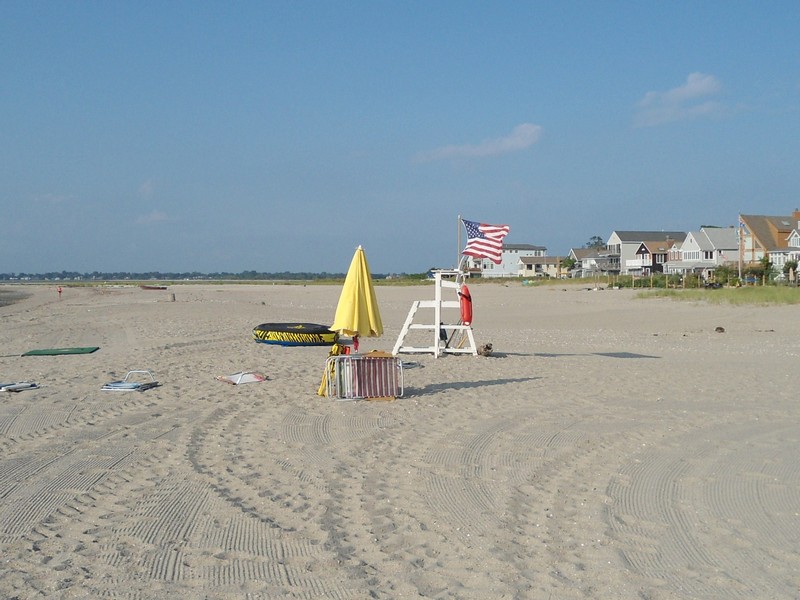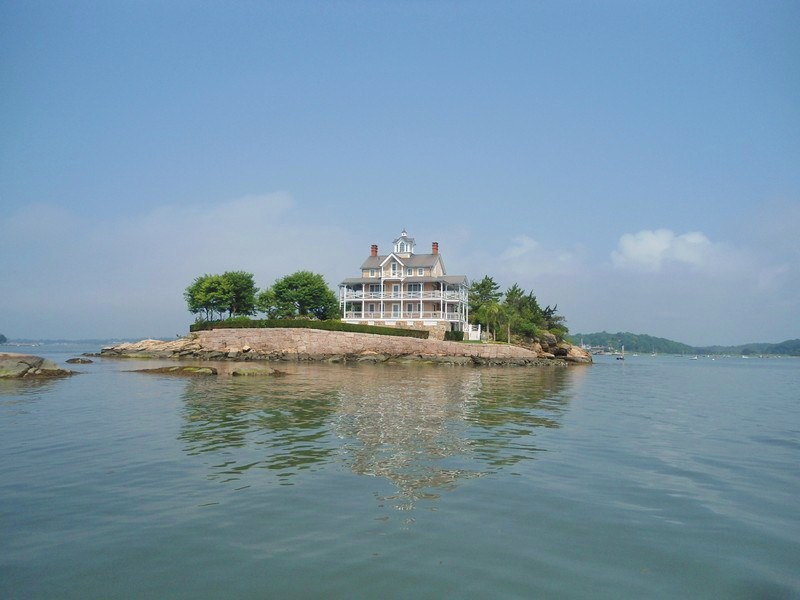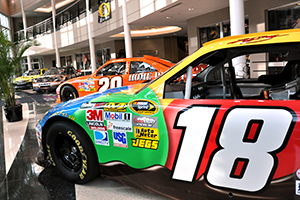While visiting Hilton Head Island in South Carolina, I had a chance to sail on Stars & Stripes 1987, the 12 Meter yacht that played such an important part in America’s Cup history. The story begins in Newport, Rhode Island. 24 times, the fastest yachts in the world converged on Newport, determined to win the America’s Cup. 24 times, they sailed for home disappointed.
The Famous Winged Keel Controversy
In September of 1983, a team from Perth, Australia, brought their innovative yacht, Australia II, to Newport. Australia II was the first boat ever to have a so-called “winged keel.” It featured two surfaces jutting out from the bottom of the keel, one on each side. And it was fast. The New York Yacht, custodians of the Cup for more than 100 years, insisted that keel was illegal. Before every race, they filed a protest and every time the official measurer declared the boat complied with every jot and title of the rules.
Liberty, the American defender, was skippered by Dennis Connor and was noticeably slower than the challenger. Only by superior tactics and skill was Connor able to compete with the Aussie boat. At the end of 6 races, the series was tied — 3 wins apiece.
Going Off On A Flyer
America’s Cup competition is match racing — two boats, one course. First to cross the finish line wins. No tears. There is one cardinal rule in match racing. The boat ahead sticks like glue to the boat behind. Wherever it goes, the leader goes.
There is an old expression in sailing: We cannot control the wind. All we can do is adjust our sails. Wind is not a constant thing — it comes first from one direction, than a few seconds later from another. If you allow the boat behind to sail off all alone, it might find better wind somewhere else. That’s why a seasoned match racer never, ever, under any circumstances, lets the trailing boat get away.
In the seventh race, Liberty had a commanding lead rounding the next to last mark. The wind that day was light and flukey. In a desperate search for a stronger breeze, Connor decided to sail off in the general direction of Portugal. Australia II sailed straight for the last mark. When the boats came together, Liberty’s lead had evaporated and it found itself over two minutes behind.
The Man Who Lost The Cup
Connor immediately became “the man who lost the Cup.” He was shamed throughout yachting circles and vilified wherever he went. Some believe he lost the last race deliberately so control of the America’s Cup would be wrested away from the New York Yacht Club.
It was well known that Connor and the NYYC despised each other. Connor had many innovative ideas about how the America’s Cup competition should evolve in the future. The NYYC wanted no part of any such frippery and tomfoolery.
Undaunted, Connor immediately set about organizing a challenge to recover the Cup based at the San Diego Yacht Club. 4 years later, he went to Australia with Stars Stripes 1987, the 55th 12 Meter yacht ever built. It was designed specifically for the heavy seas and high winds found in the Indian Ocean off the west coast of Australia.
https://www.youtube.com/watch?v=OxJOnDlz9tE
A Triumph For Dennis Connor
But before it could challenge for the Cup, it needed to win the challengers series against boats from other countries. Eventually it came down to two — Stars & Stripes 1987 and KZ 5, the challenger from New Zealand. In the final and deciding race, Connor was leading when the genoa jib on Stars & Stripes exploded. As Connor’s crew struggled to replace the jib, KZ 5 sailed on by, certain that victory was theirs.
Unbelievably, Connor maneuvered his crippled boat with such expertise that he surprised the Kiwis at the final mark and went on to win the race and the right to challenge for the America’s Cup. The series itself was anti-climactic. Connor and Stars & Stripes bludgeoned the Australians into submission, taking 4 races in a row to bring the Cup back to the US.
As a young man who grew up sailing on Narragansett Bay, I followed America’s Cup racing passionately. In the days before DVR’s, I was the only person I knew who stayed up until 3 am to watch the races live from Australia. When Connor and Stars & Stripes paraded back into the harbor after reclaiming the Cup I was ecstatic, although I never quite forgave Connor for losing it i in the first place.
Gary Jobson, a renowned America’s Cup sailor in his own right, said after the series, “The Stars & Stripes campaign of 1986-87 was the triumph of Dennis Conner. The events of 1983 were crushing. Dennis was hurt and vilified. He was made the scapegoat. To win after going through that was the story.”
The Sailing World Shifts On Its Axis
What happened next was the stuff upon which legends are built. Michael Fay, a wealthy industrialist from New Zealand, issued a challenge to the San Diego Yacht Club to contest for the Cup the following year. Ordinarily, the Cup races were scheduled 3 to 4 years apart. 21 syndicates had made their intentions known to compete in 1991, but Fay took his challenge to the New York Supreme Court which interpreted the original Deed of Gift to the New York Yacht Club in Fay’s favor.
The Deed specified only that the boats would have but one mast and be not more than 90 feet in length. Fay announced his challenger would be 90 feet long with one single mast. In fact, he already had the boat built and ready to race.
Connor and the SDYC were caught flat footed. They had no such boat ready and could not design and build one in time. But Connor, the wily strategist, had an answer. The San Diego defender would be a catamaran. Strictly speaking, it complied with the strict terms of the Deed of Gift.
Multi-hull Boats Rule The Seas
Connor beat the Kiwi boat and the era of multi-hull racing had come to America’s Cup competition. Today, as this is being written, catamarans representing Sweden and New Zealand will face each other for the right to challenge Team USA in the 2017 round of the competition. The old 12 Meter yachts had a maximum hull speed of about 17 knots on a windy day. Today’s boats are more like jet fighters than sailboats and can reach speeds of 50 knots.
The racing is exciting, intense, edge of your seat, stuff. And it exists because Dennis Connor went to Perth with Twelve Meter 55 — Stars & Stripes 1987 — and brought the Cup home in convincing style.
Standing In The Shadow Of Dennis Connor
I was thinking of all that history as I took the helm of 12 Meter 55 out of Harbor Town and sailed under reef through the waters of the Intercoastal Waterway. I stood where Dennis Connor stood. Put my hands on the wheel just as Connor had 40 years ago. The rest of the people on board were just tourists with no idea that the boat they were sailing on had once been a vital part of America’s Cup history.
But I knew. I could feel the energy field that still envelopes Stars & Stripes 1987. It’s there if you understand the history of the vessel and grew up steeped in America’s Cup lore. And while I sailed, I was channeling Jimmy Buffett: “Follow in my wake, there’s not that much at stake; for I have calmed the seas and smoothed the troubled waters…..”
I was sitting in a dentist’s chair in 1978, listening to a live broadcast of the race on the radio. When Connor sailed off toward the horizon and let the Aussies cruise home to victory, I almost bit the drill in half in anger and frustration. But now I have felt the aura of Dennis Connor and I just want to say, “Dennis, I forgive you.”
Everything Old Is New Again
There is a codicil to this story. The Herreshoff brothers, Nathiel and John, designed and built a number of America’s Cup defenders at their boatyard in Bristol, Rhode Island. Hanging from the rafters in the Herreshoff Museum is a strange craft. It looks like a wooden pancake straddling two kayaks. It was built in 1898 and submitted to the New York Yacht Club as a potential America’s Cup defender.
The NYYC promptly ruled the design ineligible because it would too fast! The Herreshoffs, like Dennis Connor, were way ahead of their time.








